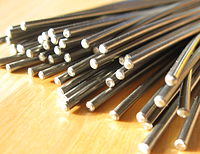
Photo from wikipedia
Purpose The purpose of this study was to investigate the effects of deformation-induced martensite on electrochemical corrosion behaviors of 304 austenitic stainless steel in a simulated primary water environment of… Click to show full abstract
Purpose The purpose of this study was to investigate the effects of deformation-induced martensite on electrochemical corrosion behaviors of 304 austenitic stainless steel in a simulated primary water environment of a pressurized water reactor nuclear power plant with boric acid and lithium hydroxide contaminated with chloride by potentiodynamic polarization, electrochemical impedance spectroscopy (EIS), Mott–Schotty curves and X-ray photoelectron spectroscopy (XPS). Design/methodology/approach The effects of deformation-induced martensite transformation on electrochemical corrosion behaviors of 304 austenitic stainless steel was investigated in a simulated primary water environment of a pressurized water reactor nuclear power plant with boric acid and lithium hydroxide contaminated with 0.1 M Cl− by potentiodynamic polarization, EIS, Mott–Schotty curves and XPS in this paper. Findings The results revealed that the martensitic phase contents increased with the level of cold deformation. The general corrosion current density and the corrosion potential increased and decreased, respectively, with the increase of cold deformation degree. However, the pitting potential decreased as the cold deformation increased up to 20 per cent, then a slight increase was observed at 35 per cent cold working. It was found from Mott–Schottky curves and XPS analysis that as the cold deformation degree increased from 0 to 35 per cent, the doping concentrations of the oxide films increased; however, the film thickness decreased, which indicates that both density and integrity of the films are degraded significantly as the deformation degree increases, and this ultimately contributes to the significant increment of the general corrosion rate and reduction of the pitting corrosion resistance. Originality/value The effects of deformation-induced martensite transformation on electrochemical corrosion behaviors of 304 austenitic stainless steel was investigated in a simulated primary water environment of a pressurized water reactor nuclear power plant with boric acid and lithium hydroxide contaminated with 0.1 M Cl− by potentiodynamic polarization, EIS, Mott–Schotty curves and XPS in this paper.
Journal Title: Anti-corrosion Methods and Materials
Year Published: 2017
Link to full text (if available)
Share on Social Media: Sign Up to like & get
recommendations!